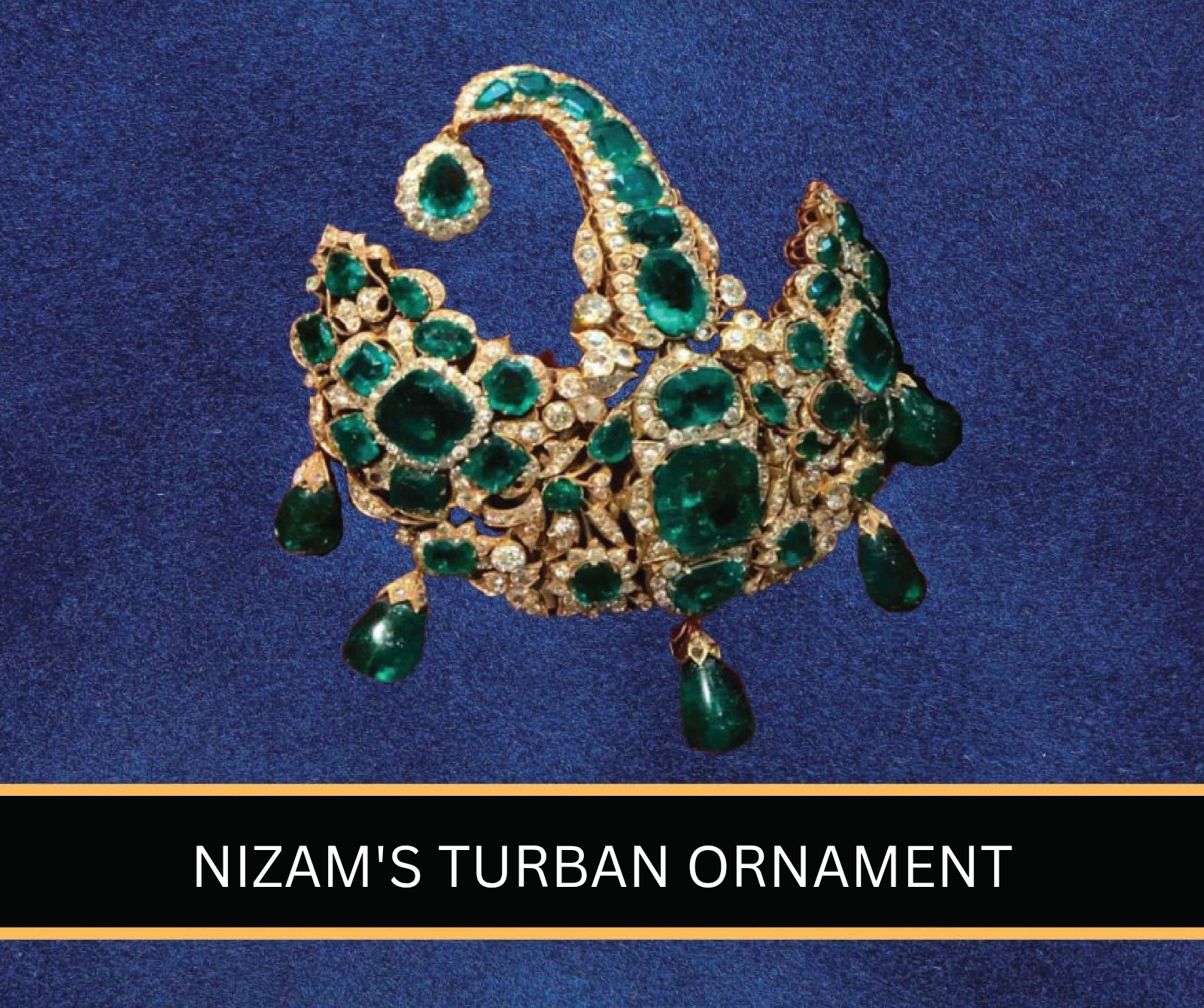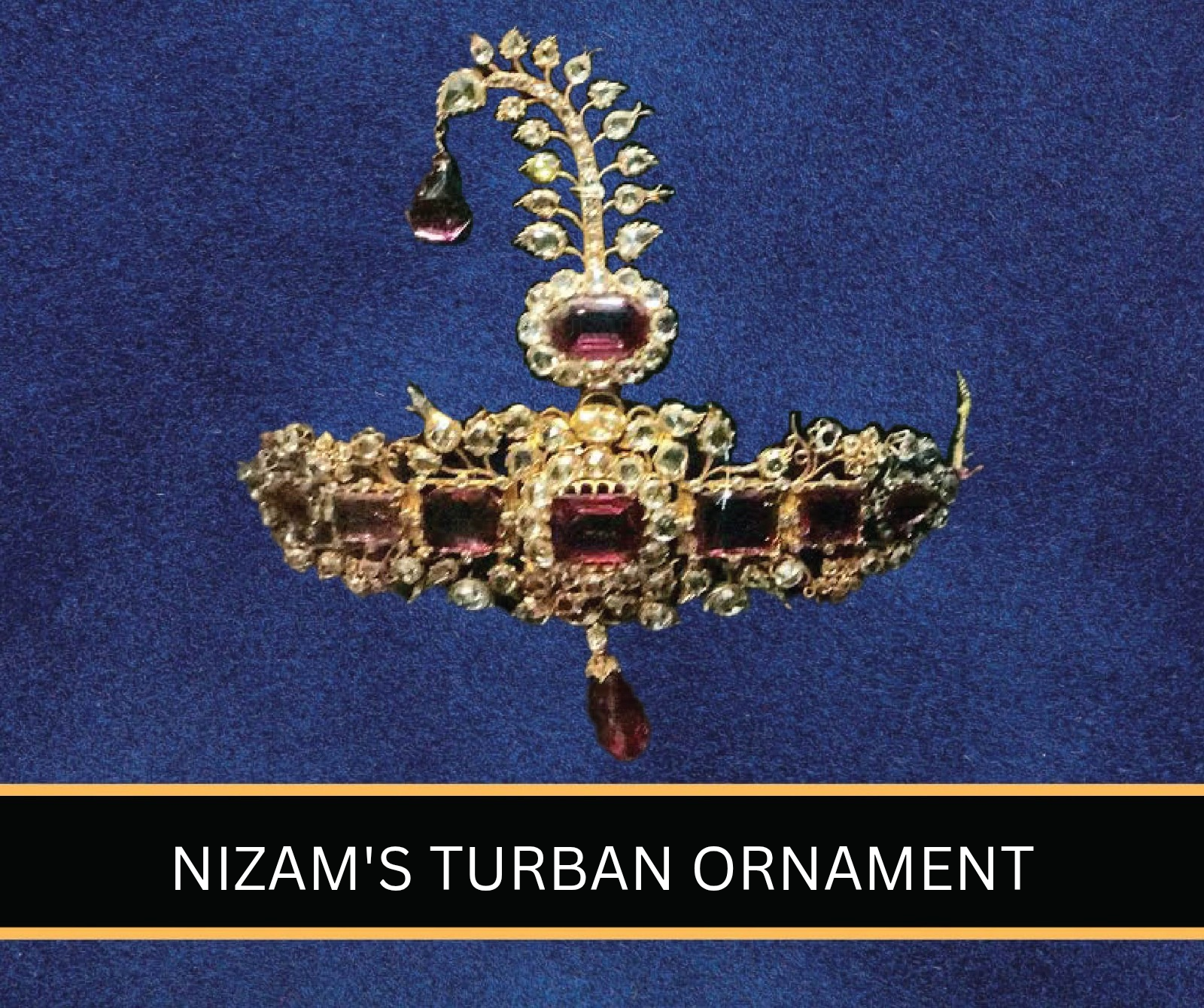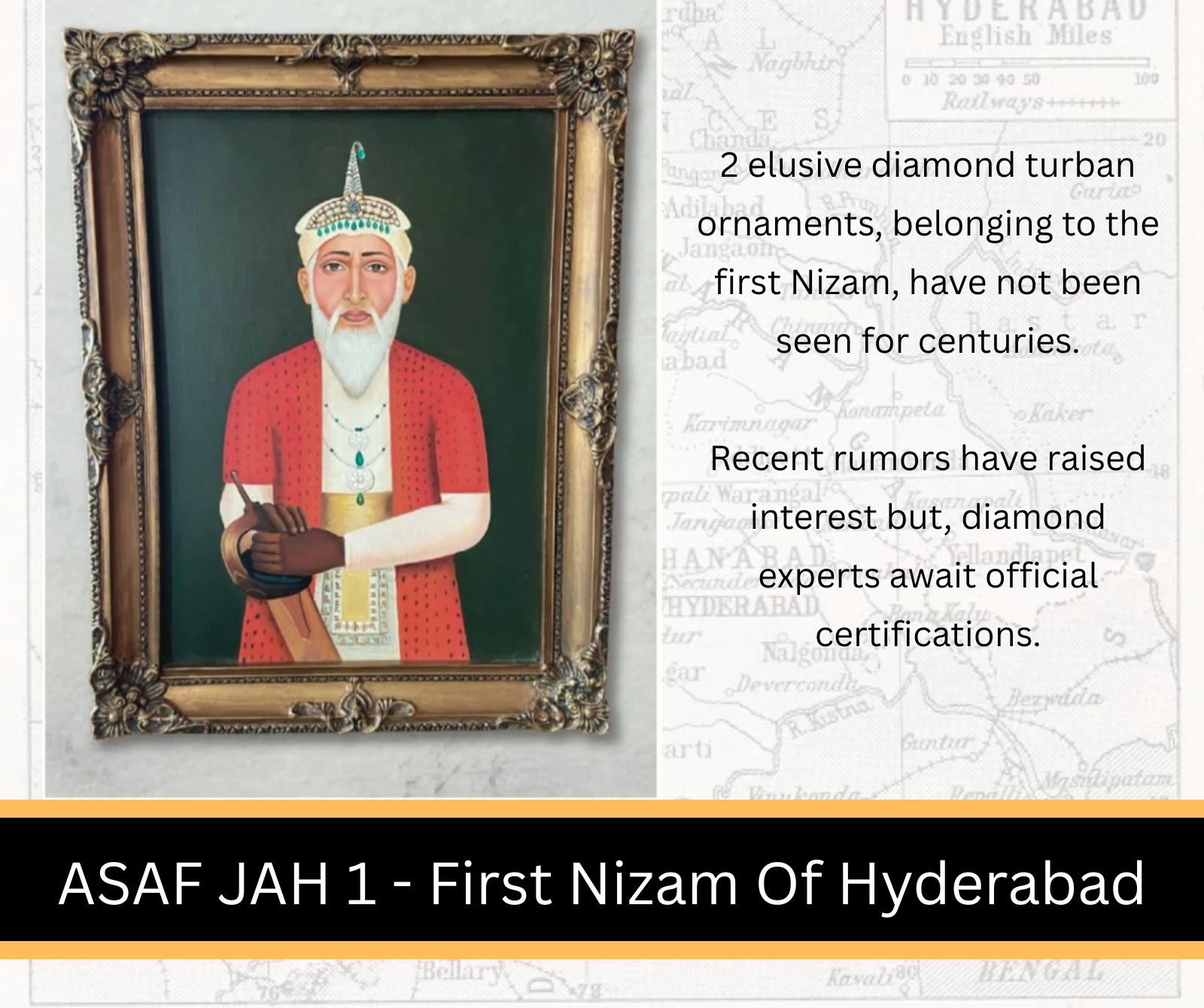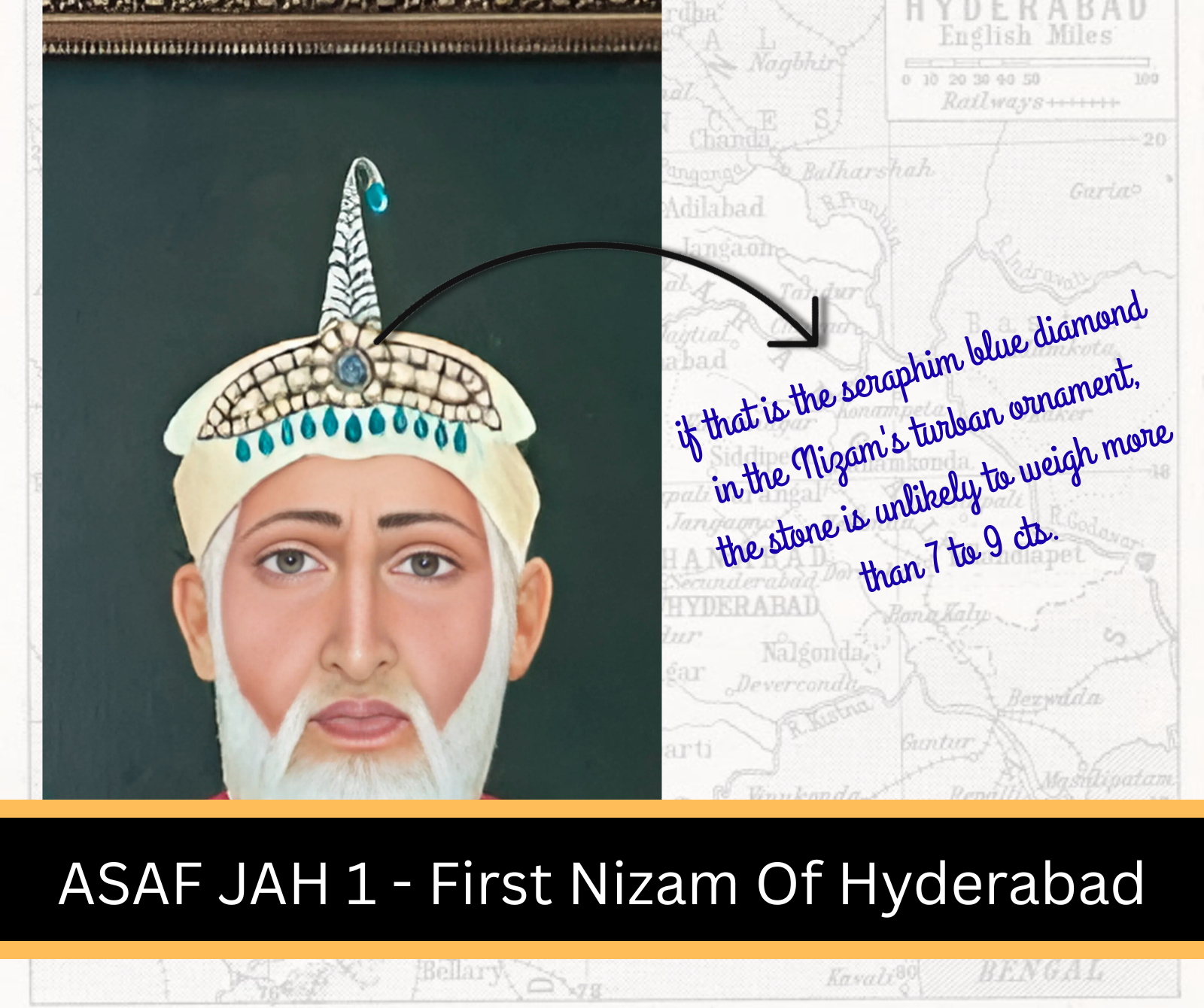Diamonds In Nizam Turban Ornaments
The turban ornaments (or sarpech) of the Nizams of Hyderabad were often opulent and richly adorned with emeralds, sapphires, and rubies. These gemstones were not only prized for their beauty but also symbolized power, royalty, and divine favor in the Indian subcontinent. The Nizams had access to some of the finest gemstones, including Colombian emeralds and Burmese rubies. Talking about the most highly sought after precious gems in history.


As for diamond turban ornaments, it is indeed plausible that some of the more valuable ones were lost, stolen, or looted — especially during times of political transition, royal disbandment, or private sales. Two specific mentions in recent years have an interesting story, which even seasoned diamond collectors would not disbelieve. However the point is that, while the narratives for these diamond turban ornaments, worn by the Nizams appear authentic - there is a need for official authentication from reputed diamond testing houses. This in most cases would imply authentication certificates by testing houses like GIA and Gubelin.
These turban ornaments weren’t just accessories — they were political and cultural statements worn during formal court gatherings, ceremonies, and royal portraits. It is very possible that the Nizam's diamond turban ornaments, were worn only for very special occasions. Making a mention of a vivid blue diamond and a fancy pink diamond, that have been rumored to have been set in turban ornaments, owned by the Nizams.
Pending official authentication but, adding some important notes here. The blue diamond is likely to have come from the Golconda mines, let us not forget that the Nizams controlled the Golconda diamond mines from 1724 to around 1948. And if the story that, the first Nizam (Asaf Jah 1), wore the blue diamond turban ornament is authenticated - many other inferences would fall into place. Stories and versions abound but, experts are equipped with the knowledge and experience to separate the reality from personal opinions. Not much is being mentioned about the pink diamond, which was supposed to have been part of a diamond turban ornament worn by the Nizams - but, a fair amount of 'detail' has emerged regarding the blue diamond.
The narrative about the vivid blue diamond that was once. part of a turban ornament worn by the first Nizam of Hyderabad claims that, Asaf Jah 2 the second Nizam of Hyderabad handed over that blue diamond to the French. Apparently this was transacted, to gain military support from the French. Authenticating all this information would, add a new dimension to the story. Saying this because the blue diamond turban ornament, does not seem to have a mention during the reign of subsequent Nizams. So the claim that the turban ornament with the blue diamond, was worn by Asaf Jah 1 and made an exit during the reign of Asaf Jah 2, holds significance.
One detail that seems to have been missed in many reports refers to the diamond, being separated from the turban ornament. It is not known whether the blue diamond which was believed to be worn in a turban ornament by the first Nizam, remained in the ornament or was subsequently separated from the gold portion.
Certain reports claim that the blue diamond, is currently in the collection of a Russian collector who is passionate about historic diamonds. Other reports refer to a European collection without, specifying a Russian collection. The Nizams possessed exquisite diamond pieces. However, not all of these treasures were documented or preserved in museums, making it easy for some to vanish over time.
ADDED INFO
Referring to the information related to the missing diamond turban ornaments, mentioned above in this report. Previous rumors narrated how two priceless diamond turban ornaments, belonging to Asaf Jah 1 the first Nizam of Hyderabad, were untraceable. While one of these turban ornaments had a pink diamond in the center, the other piece was graced by a fine blue diamond in the center. Not much interest was shown towards such rumors but, mutiple reports claiming similar stories have emerged in recent times. A framed painting of the first Nizam is attracting attention, the turban ornament seems to have a blue stone in the center. While the color does not resemble a blue sapphire - it is important to keep in mind that, this is a painting and not a photograph. Some critics have questioned the authenticity of the painting but, that is really irrelevant. Some information of the blue stone can be used to assess important elements like dimensions (weight). The information will be valuable to enable cross-checks if and when, the elusive blue daimond makes an appearance.


The diamond in the turban ornament is being referred to as the Seraphim Blue Diamond, never mind if the name does not sound familiar - this diamond has never really been put up for a high profile sale or auction. None of famous diamonds were really 'born' with a name, they were named as a unique identification became necessary. A look at the picture and the other information rumored earlier, a significant portion of the elusive blue diamond in the Nizam's turban ornament can be hypothetically compiled.
Hypothetical Profile
This is a summary of what diamond experts and reputed auction houses, would expect to see in the Seraphim Blue Diamond and the accompanying certifications - until that time, we will refer to these features as being merely hypothetical. The Seraphim Blue Diamond is expected to have a highly desirable blue color, color coding centuries ago might have not been very objective - current certifications will clarify color. We are being made to believe that the blue diamond set in the turban ornament worn by Asaf Jah 1, was mined in the Golconda mines and that the piece has a striking degree of clarity.
Another vital piece of information can be clarfiied from the framed painting, this by observing the dimensions of the whole turban ornament, the estimated size of the forehead and the carat weight of the so called Seraphim Blue Diamond. One thing is very sure - that the blue diamond in the turban is not super big, diamond experts woulld put an estimate of around 6 to 9 carats for the piece.
The assessed diamond weight of 6 to 9 carats for the Seraphim Blue Diamond, was revealed during the super touted Christie's announcement of another Golconda diamond, that piece weighed 23.24 carats and was being estimated at $60 million to $100 million! The downside of the much touted diamond was that, its provenance was dated back to recent times, around 1990 to be more precise. The Seraphim Blue Diamond claims to have been worn by the first Nizam of Hyderabad, time frame at around 1724! The big blue diamond auction was cancelled for strange reasones - a shocking decision and probably the first such case, in the history of Christie's long diamond auction track record. The Golconda Blue Diamond which was suppossed to be auctioned, was at times mistaken for the elusive Seraphim Blue Diamond. Experts were quick to clarify that, the blue diamond in the Nizam's turban ornament was unlikely to weigh more than 7 to 8 carats. The picture of the Nizam in the frame, seems to confirm that weight assessment.
All the above information related to the Serphim Blue Diamond is hypothetical - it will remain so until the piece is revealed and comes with documentation that is certified by a reputed diamond testing house. And if and when it does appear, experts will surely cross check the piece against widely rumored information made available across multiple reports. Doubts will rightly be raised if, some of the main features of the physical diamond,do not tally with the pieces of information that have been rumored.
NOTES
The content in this report has been compiled purely for informational purposes. We do not have any commercial interest in any of the assets mentioned in this report. Due diligence on every aspect is expected to be done, by interested investors. None of the information presented in this report should be taken as a substitute for expert knowledge and advice.
